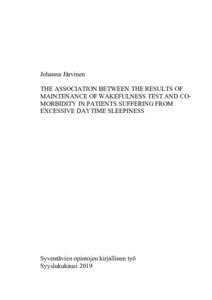The association between the results of maintenance of wakefulness test and co-morbidity in patients suffering from excessive daytime sleepiness
Järvinen, Johanna (2020-01-16)
The association between the results of maintenance of wakefulness test and co-morbidity in patients suffering from excessive daytime sleepiness
Järvinen, Johanna
(16.01.2020)
Julkaisu on tekijänoikeussäännösten alainen. Teosta voi lukea ja tulostaa henkilökohtaista käyttöä varten. Käyttö kaupallisiin tarkoituksiin on kielletty.
avoin
Julkaisun pysyvä osoite on:
https://urn.fi/URN:NBN:fi-fe202001304018
https://urn.fi/URN:NBN:fi-fe202001304018
Tiivistelmä
Obstructive sleep apnea (OSA) and narcolepsy cause excessive daytime sleepiness (EDS) and hypersomnia. Daytime sleepiness can be measured by the maintenance of wakefulness test (MWT). OSA and upper airway resistence syndrome (UARS) patients frequently have abnormal MWTs. Co-morbidities and medication of patients are likely to influence the results of MWT. We set out to study the association between MWT sleep latencies and patients’ background characteristics and co-morbidity.
We studied retrospectively 506 MWTs in 361 patients. MWT testing was performed between January 2006 and November 2014. We gathered also information about age, gender, BMI, smoking, snoring, waist circumference, disease burden, diagnostic cardiovascular polygraphy, medication, CPAP-treatment, ESS, GHQ-12 and DEPS scores and subjective sleep quality. Then we examined how sleep latiencies in the MWT were influenced by these factors.
We found that professional drivers, sleep apnea patients and men were more alert than non-professional drivers, patients without sleep apnea or women, respectively. Patients suffering from long-term snoring and using almost all types of medication had worse results in MWT compared to others. Higher scores in ESS, GHQ-12 and DEPS questionnaires associated with shorter sleep latencies. We conclude that gender, sleep disorder type, co-morbidity and medication influence the results of MWT.
We studied retrospectively 506 MWTs in 361 patients. MWT testing was performed between January 2006 and November 2014. We gathered also information about age, gender, BMI, smoking, snoring, waist circumference, disease burden, diagnostic cardiovascular polygraphy, medication, CPAP-treatment, ESS, GHQ-12 and DEPS scores and subjective sleep quality. Then we examined how sleep latiencies in the MWT were influenced by these factors.
We found that professional drivers, sleep apnea patients and men were more alert than non-professional drivers, patients without sleep apnea or women, respectively. Patients suffering from long-term snoring and using almost all types of medication had worse results in MWT compared to others. Higher scores in ESS, GHQ-12 and DEPS questionnaires associated with shorter sleep latencies. We conclude that gender, sleep disorder type, co-morbidity and medication influence the results of MWT.
